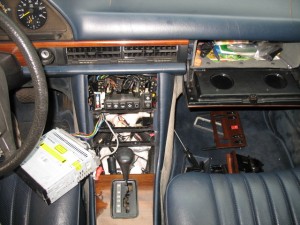This morning was spent putting a new (old) stereo in Sherman. I had replace the original in the car for a new one which failed after two years. I had saved the old one so it went back into the car. This time I fabricated a 12 pin connector for the car wiring harness. It will make it really easy replace this radio for a new HD radio with iPod input and Blue Tooth capability easier to do. Eventually, I want to move up to more modern electronics.

Panels, panels, panels. Today was a fund day of installing a bunch of panels in the plane. My goal is to make this plane look close to a car! I think new cars are a work of art. Take a good look at a Volkswagen. Their interiors are beautifully functional, efficient and crisp! I love the refined, elegant and luxurious nature of a Lexus.
When you look at most canards they are wonderfully simple, very light weight, easy to build but unfortunately very basic. Whenever I get into a nice car, I think why does my costly and major cool looking air plane look so utilitarian and well clunky on the inside. Uncomfortable, cold, the rain drips comes in, hot, drafty. Alas, the secret is out. Tweety has a great looking body, but sort of plane a Jane on the inside (were it counts).
Mygoal with pPod is to use wasted space and to transform her into something closer to the look and feel of a ….well… and old 1981 Mercedes SD300 Turbo. What a remarkable idea! If it is good enough for Sherman, then it is should be good enough for pPod. To do so I need cover panels….lots of them.
This is the back panel for the rear head rest and cover for the aft (main) battery.

This is the Starboard panel. At the top will be the eyeball vent followed by the electronics input panel. I will make a cover for the rear stick so when carrying baggage in the back seat there will be no possibility of interferingwith the flight control system. Add a nice arm rest panel for a bit of elegance!

This is the Port panel. A 12v dc outlet and a pocket (accessible from the front seat) will be installed for maps or possibly a new ebook reader. Pat talked me into making a foot panel and cover for the electric actuator for the belly board. The foot panels will also have some built in storage.

For those who dont know An eBook reader is you should check them out at Wikipedia. Even a basic one could easily contain all the approach plates for the entire USA and Canada and plenty of extra room for other reading material. One wouldnt have to carry so many books and weight for a LONG cross county trip (such as Charleston to Los Angles) and ereaders are much easier to use. You can get the approach files at NACOmatic.com . What a great resource and are FREE and current!
The only reason I dont buy an eBook reader right now is that in the next 3 months a whole slew of new eReaders are going to being released. EBooksare the “new” must have technology. Hell with the Apple iPhone, iTouch you NEED an eBook reader. Amazon, Barnes & Noble, Sony, Freescale, PaperLogic and a host of others are all getting on the etrain and bringing out new and innovative ereaders. The choices right now are slim and most lack even basic Internet capabilities. The cost range will be about $150-$400. A few standouts (Paper Logic) will be about $550 or so due to ‘advanced’ features.
I am looking for something that will be close in size to a standard approach plate, has WiFi and can interact with the web (so I can do flight planing). Has to have an SD card slot and support standard .pdf files. By January 2010, all the first generation choices (black and white) will have been released to market place and a decision can be made. I’ll have a new toy and the bird will lose a few pounds.
Here are nine new ereader which will be coming out shortely.
I predict in a few years, ebook readers will morf into a ebook ereader netbook with full Internet capabilities using a color touch screen. The main difference between an ebook and a computer will be the inability to load programs to create content independent of the web. The ebook will be able to open and read any format document (with appropriate plug-ins), annotate documents (pdf markup touch screen), display static color pictures (since the electronic ink does not easily change states) and finally get on line (WiFi) and interact with on line programs. This will reduce the processing power needed on netbook ereader since all the processing and storage will be done on the web (Cloud Computing). Technology is changing once again to something new and exciting!






































